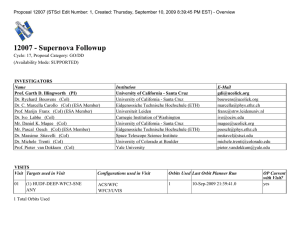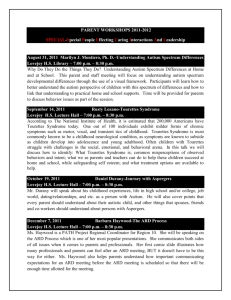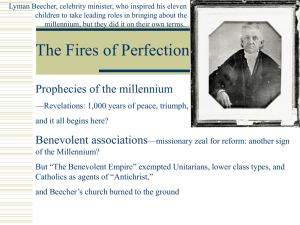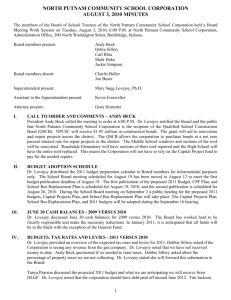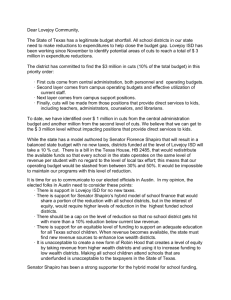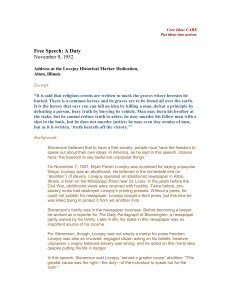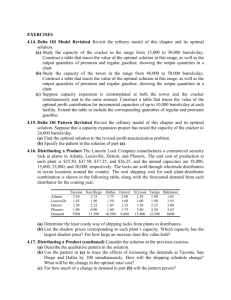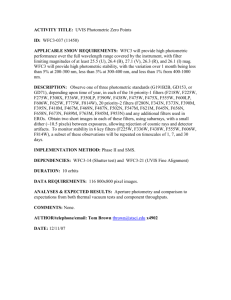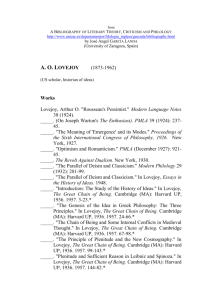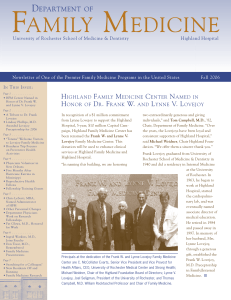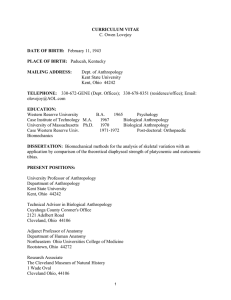Document 10417735
advertisement
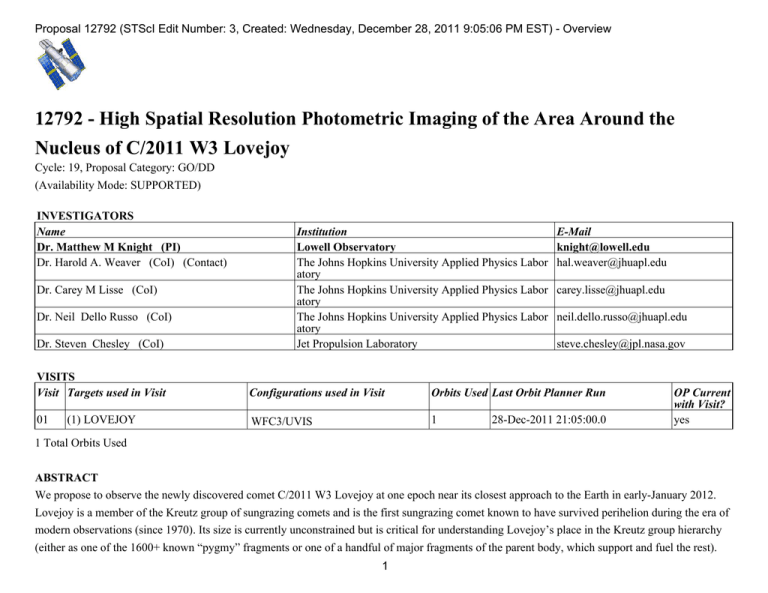
Proposal 12792 (STScI Edit Number: 3, Created: Wednesday, December 28, 2011 9:05:06 PM EST) - Overview 12792 - High Spatial Resolution Photometric Imaging of the Area Around the Nucleus of C/2011 W3 Lovejoy Cycle: 19, Proposal Category: GO/DD (Availability Mode: SUPPORTED) INVESTIGATORS Name Dr. Matthew M Knight (PI) Dr. Harold A. Weaver (CoI) (Contact) Dr. Carey M Lisse (CoI) Dr. Neil Dello Russo (CoI) Dr. Steven Chesley (CoI) Institution Lowell Observatory The Johns Hopkins University Applied Physics Labor atory The Johns Hopkins University Applied Physics Labor atory The Johns Hopkins University Applied Physics Labor atory Jet Propulsion Laboratory E-Mail knight@lowell.edu hal.weaver@jhuapl.edu carey.lisse@jhuapl.edu neil.dello.russo@jhuapl.edu steve.chesley@jpl.nasa.gov VISITS Visit Targets used in Visit Configurations used in Visit Orbits Used Last Orbit Planner Run 01 WFC3/UVIS 1 (1) LOVEJOY 28-Dec-2011 21:05:00.0 OP Current with Visit? yes 1 Total Orbits Used ABSTRACT We propose to observe the newly discovered comet C/2011 W3 Lovejoy at one epoch near its closest approach to the Earth in early-January 2012. Lovejoy is a member of the Kreutz group of sungrazing comets and is the first sungrazing comet known to have survived perihelion during the era of modern observations (since 1970). Its size is currently unconstrained but is critical for understanding Lovejoy’s place in the Kreutz group hierarchy (either as one of the 1600+ known “pygmy” fragments or one of a handful of major fragments of the parent body, which support and fuel the rest). 1 Proposal 12792 (STScI Edit Number: 3, Created: Wednesday, December 28, 2011 9:05:06 PM EST) - Overview Kreutz comets are known to fragment frequently, and we expect that Hubble’s high spatial resolution will reveal individual fragments undetectable by any other means. We will estimate the size distribution of these fragments. Due to Lovejoy’s extreme southern declination, small solar elongation, and 300+ year orbit, these observations can only be obtained using Hubble, and cannot be accomplished at any other epoch. OBSERVING DESCRIPTION We will obtain 6 x 350s exposures using the F606W filter. We will use two different dither positions (3 images at each dither location) to fill-in the gap between the two CCDs and to mitigate the effects of bad pixels. If necessary, the exposure time for the sixth image should be reduced to fit the observations into one orbit. 2 Solar System Targets Diagnostics Visit Proposal 12792 - Visit 01 - High Spatial Resolution Photometric Imaging of the Area Around the Nucleus of C/2011 W3 Lovejoy Proposal 12792, Visit 01, scheduling Diagnostic Status: Warning Scientific Instruments: WFC3/UVIS Special Requirements: DROP TO GYRO IF NECESSARY ; BETWEEN 07-JAN-2012 AND 11-JAN-2012 (Visit 01) Warning (Orbit Planner): VISIBILITY OVERRUN # (1) Level 1 Level 2 TYPE=COMET,Q=0.0055547725139 74684,E=0.9999271792540354,I=134. 4069584659192,O=326.520935644692 ,W=53.61581727191412,T=16-DEC2011:00:20:00,TTimeScale=TDB,EQ UINOX=J2000,EPOCH=08-JAN2012,EpochTimeScale=TDB Level 3 Window MOSS Planning Start: 01-JAN2012:00:00:00 MOSS Planning End: 31-MAR2012:00:00:00 Ephem Center EARTH Comments: Acquisition Uncertainty: 10 Arcsec Ephemeris Uncertainty: 3625 Kilometers # 1 Exposures Name LOVEJOY Thu Dec 29 02:05:07 GMT 2011 2 Label Target (1) LOVEJOY (1) LOVEJOY Config,Mode,Aperture WFC3/UVIS, ACCUM, UVIS1 WFC3/UVIS, ACCUM, UVIS1 Spectral Els. F606W F606W Opt. Params. CR-SPLIT=NO CR-SPLIT=NO 3 Special Reqs. Groups REQ EPHEM CORR LOVE01; GS ACQ SCENARI O SINGLE POS TARG 0.2,2.41; REQ EPHEM CORR LOVE01 Exp. Time/[Actual Dur.] 350 Secs X 3 [==>(Copy 1)] [==>(Copy 2)] [==>(Copy 3)] 350 Secs X 3 [==>(Copy 1)] [==>(Copy 2)] [==>(Copy 3)] Orbit [1] [1] Orbit Structure Proposal 12792 - Visit 01 - High Spatial Resolution Photometric Imaging of the Area Around the Nucleus of C/2011 W3 Lovejoy 4
